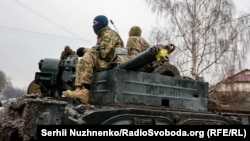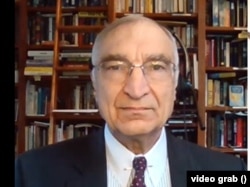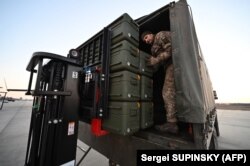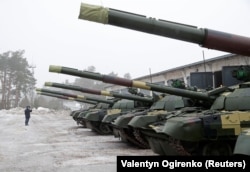As the Ukraine war shifts its focus to the country’s east and south, Kyiv is calling on NATO countries to provide all the weapons it says it needs to push back Russian forces.
It was recently announced that the Czech Republic sent a dozen Soviet designed T-72 tanks as well as howitzer artillery pieces and armored vehicles to Ukraine, signaling a new level of support and that Kyiv’s requests are being heard. Other countries, such as Poland and the United Kingdom, are believed to also be stepping up shipments, and the United States continues to supply more equipment after recently announcing hundreds of millions of dollars in new spending for Ukraine.
To give a little perspective, in 10 years of fighting in Afghanistan, the Soviet Union lost about 15,000 dead. Russia may have lost that in the first four weeks of this war."
This comes as Ukrainian forces may need to change tactics as they focus their attention on Russian troops in the east and south that are better positioned than the armored columns that Ukrainian fighters were able to pick off with their light infantry using anti-tank missiles around Kyiv and the northeastern part of the country.
Russia is currently repositioning and refitting its forces as it adapts its goals for its invasion of Ukraine following heavy losses, with Moscow hoping it can control Mariupol, capture all of the territory claimed by Russia-backed separatists in Donetsk and Luhansk, and encircle Ukrainian forces in the area.
To better understand what lies ahead, RFE/RL spoke with Mark Cancian, a retired U.S. Marine colonel and senior adviser at Washington's Center for Strategic and International Studies.
RFE/RL: Moscow is seeking to wage a more conventional military-on-military war in the Donbas and in the south of Ukraine. How do those coming fights measure up and how different will this be from what we’ve seen from around Kyiv, especially given that Ukraine now has to deal with Russian forces that have made more defensible gains and are better dug in?
Mark Cancian: I think the Russians are doing what they should have done militarily three weeks ago, which is to focus their effort [and] mass their forces in the areas where they've had the most success. That would be in the south, around Mariupol, and they're also coming in from the north and from the Donbas region in the east.
One of the objectives of the Russian offensive has been to increase their gains in the Donbas and to take over those areas. So, it's not surprising that they're mobilizing forces there. It's a bit dangerous for the Ukrainians because there's a possibility that the Russians could get behind them.
The fact that the West has been supplying not just anti-tank weapons [and] anti-aircraft weapons, but also artillery shells and bullets, and just day-to-day supplies, it’s all terribly important."
The Ukrainians have been very stubborn on the defense and while the Russians are gathering more forces [and] they pull some out [from other areas], they're still probably going to need to refit and redeploy them. Although it's going to take some time to refit those forces. Many of them -- especially the ones up by Kyiv -- were badly chewed up. It will take a while to get replacement equipment, reinforcements, rest them, and then bring them around.
RFE/RL: Western intelligence officials believe that Russian President Vladimir Putin will want an “announceable success” for the country’s traditional Victory Day parade on May 9. Will this timeline affect how the next month of war will unfold and does it create pressure for Russia, Ukraine, and Western countries?
Cancian: It’s not clear how that date [could] affect military operations.
I think the generals have made it clear what they're trying to do, [which is] move bit by bit in the east. They've stopped offensives in other areas. It’s not clear to me that the Russians have another month of fighting left in them.
They've taken a lot of casualties and morale is sinking. I think that they're on a timeline here and if they don't get success soon, they're just going to stalemate, and that would be very bad for the Russian military.
RFE/RL: We are seeing a shift in terms of Western countries supplying more “offensive” weapons to Ukraine, something that they had previously resisted. Can Western-supplied equipment tilt the fight in Ukraine’s favor and should we expect Kyiv to get the types of weapons that it has been asking for?
It's going to take [Russia] a lot of time to refresh the forces that have been in combat, and you have to keep in mind that they've lost a lot of people."
Cancian: The West has been sending equipment that either Ukrainians already use or that they can easily train on, like Javelin [missiles] and various anti-tank missiles, and also Stingers and other anti-aircraft missiles.
I think that will continue. They’re clearly sending a few other major weapon systems, like tanks, that the Ukrainians already operate, so it's easy to incorporate them into their training and logistics base. [But] I think it's going to be hard to expand that too much.
[Ukrainian President Volodymyr] Zelenskiy talked about getting 1 percent of NATO's aircraft and tanks, but for equipment that they don't already operate, it takes months, if not years, to get the training programs, the maintenance programs, or the logistics pipelines set up to properly support them. So you're not going to see [U.S.-made] M-1 tanks show up in Ukraine.
On the other hand, sending them T-72 [tanks] that they already operate makes a lot of sense. I think that those Polish MiG-29s are going to show up someday in Ukraine. The United States sort of signaled that they're not going to make the transfer with a press conference. They're going to do it very quietly as they did with the T-72s, where they didn’t announce where they came from…. They just showed up in Ukraine.
RFE/RL: Is it correct to be focusing on the type of equipment that the Ukrainians could be receiving? Are new types of weapons the thing that's going to give Ukraine the advantage in the coming weeks?
Cancian: The biggest thing is munitions because that's what keeps a military fighting.
The fact that the West has been supplying not just anti-tank weapons [and] anti-aircraft weapons, but also artillery shells and bullets, and just day-to-day supplies, it’s all terribly important because it allows the Ukrainians to stay in the field. It [also] allows them to equip these militias that they recruited at the beginning of the war and that are now beginning to become effective.
The larger equipment, like tanks and aircraft, gets a lot of attention and it's worthwhile sending those, but the most important thing is to keep this flow of supplies going.
Keep in mind that the Russians aren't getting those supplies. They have to pull in munitions and supplies from other parts of the country and they're not producing them at a very high rate. So they're running their stockpiles down as the Ukrainians keep getting replenished.
RFE/RL: Russian forces seek to capture Mariupol, create a land bridge to Crimea, expand the area of occupation in the self-proclaimed republics in Donetsk and Luhansk -- and also perhaps encircle Ukraine’s main fighting force in the area. How achievable are those as objectives for the Russian military?
Cancian: Well, it's certainly a more realistic set of goals than what they had for the last couple of weeks when they were still trying to overrun the entire country. It's probably achievable, but I would say unlikely.
The Russians have just not been able to make much progress in the last three or four weeks. Now, they have a few more forces that they can bring in, [but] it's going to take them a lot of time to refresh the forces that have been in combat, and you have to keep in mind that they've lost a lot of people.
They've taken something between 7,000 to 15,000 deaths [according to some estimates], and that’s probably more now. Considering that there are probably twice as many wounded as there are killed, that means they've lost maybe 40,000 or maybe even 50,000 troops by now [from the battlefield]. Their initial forces were only about 150,000 ground combat troops -- that excludes the militias and some of the support troops -- so they may have lost over a quarter of their initial combat strength.
To give a little perspective, in 10 years of fighting in Afghanistan, the Soviet Union lost about 15,000 dead. Russia may have lost that in the first four weeks of this war.












